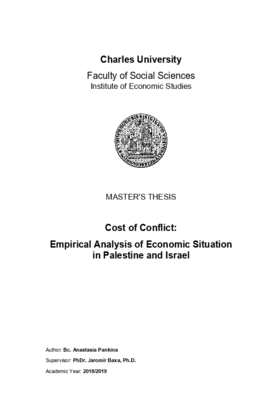Costs of Conflict: Empirical Analysis of the Economic Situation in Palestine and Israel
Náklady konfliktu - empirická analýza ekonomické situace v Palestině a Izraeli
diplomová práce (OBHÁJENO)

Zobrazit/
Trvalý odkaz
http://hdl.handle.net/20.500.11956/107684Identifikátory
SIS: 188348
Katalog UK: 990022838090106986
Kolekce
- Kvalifikační práce [19618]
Autor
Vedoucí práce
Oponent práce
Semerák, Vilém
Fakulta / součást
Fakulta sociálních věd
Obor
Ekonomie a finance
Katedra / ústav / klinika
Institut ekonomických studií
Datum obhajoby
19. 6. 2019
Nakladatel
Univerzita Karlova, Fakulta sociálních vědJazyk
Angličtina
Známka
Výborně
This thesis analyzes the Israeli-Palestinian conflict. Deeply rooted in history, and dominated by mutual violence, the conflict has been causing considerable damage to society, politics and economics for several decades. The latest attempts for the peace negotiations process failed, leading to an escalation of tensions and the Second Intifada in 2000. The Israeli West Bank Barrier has been constructed with an aim to reduce the number of terrorist attacks and to stabilize the situation of the region. By using the synthetic control method, we evaluate the impact of the Second Intifada and the Barrier on GDP per capita. The results indicate that Israel benefits from the West Bank Barrier, in 10 years the country managed to completely recover from the substantial negative effect of the Second Intifada. On the other hand, the West Bank experienced a decline in GDP per capita at the beginning of construction since the Barrier damaged properties located close to the construction and restricted movement of goods and people. A couple of years later the situation stabilized, however, the West Bank was unable to achieve full recovery from the armed uprising of 2000, and the GDP per capita growth remained limited. The estimations for the whole of Palestine reveal a negative impact, that is also attributed to...
